Those that fail to learn from history are doomed to repeat it. Luckily, the human race learns a few things sometimes.
We certainly need those lessons to handle the current Ukrainian situation.
 The start of World War II
The start of World War II
Let’s look back to the start of the last world war for a minute.
Germany had lost WWI and was heavily punished by the Versailles treaty. Besides heavy reparations, it lost territories on its East to form Czechoslovakia. Poland was given access to the Baltic Sea via a newly formed Dantzig Corridor, splitting Prussia from the German mainland. Austria-Hungary was even more drastically cut and prevented from reuniting with Germany.
As the years passed, an ambitious populist managed to leverage the frustration and humiliation of the population. He failed a coup d’état in 1923, but was eventually named chancellor in 1933, and quickly concentrated emergency powers. He eliminated opposition parties and unions. Upon the president’s death, he concentrated all powers onto him, which was confirmed by a referendum in 1934. He blackmailed the top military leaders resisting him out; he purged dozens of generals. He forced the rank-and-file soldiers to become loyal to him personally, not to the country.
He withdrew from the League of Nations and, through a referendum, annexed back the Saar in 1935. He expanded the ground army, way above the Versailles treaty’s limits. He recreated an air force and a navy. He remilitarized the Rhineland in 1936. Every time, France and the UK stayed put.
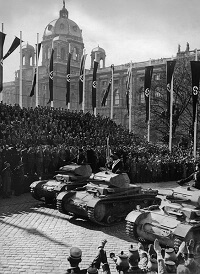
In 1936, he supported Franco in his coup, and created an axis with Italy and Japan. He was convinced that the decline in living standards could only be solved by gaining back Lebensraum eastwards, and aggressing Austria and Czechoslovakia closer. And indeed, he announced the reunification with Austria in 1938. His army marched into Vienna with public acclamation. He then claimed the Sudeten, the Western region of Czechoslovakia, whose population was German in majority.
European pacifists remembered the “Great War”, its 20 million unavailing deaths and its as many wounded, many of whom died in the following years, the destruction and the debt, the memories of the trenches, the gas attacks and all the horrors of war. The “war to end all wars” was still vivid. Nevertheless, Germany, Prague, France, the UK and Russia mobilized.
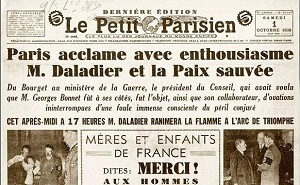
In September 1938, Hitler invited Mussolini, Chamberlain and Daladier to meet in Munich, for a last peace conference. Against his promises for peace, the allied powers gave the Sudeten away. Two weeks later, the German army invaded the region, unleashing terror. Aryanization started soon after.
In March 1939, despite his explicit promises, Hitler invaded Bohemia and Moravia.

In August that year, he also sent an ultimatum to Poland, requesting the return to Germany of Dantzig and its corridor. While pacifists again called for appeasement – “Dantzig is not worth a war” – Poland refused the ultimatum.
Germany invaded Poland on September 1st, 1939. France and the UK declared war two days later. The rest is history.
Was it worth dying for the Sudetes or for Dantzig? Bailing out in front of the threat of war did not change the outcome; war eventually consumed Europe. You could actually argue that delaying war played in Germany’s interest, as it gave Hitler more time to build his army.
A show of strength any time along the previous decade may have prevented militarization and war preparations.
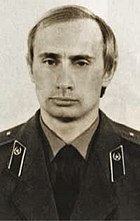 Vladimir Putin
Vladimir Putin
After joining the KGB in 1975, Putin eventually became in charge of all business approvals with the West and – surprisingly – became wealthy and influential. He grew through the ranks into a KGB senior, before resigning in 1991 and moving into politics. In 1999, he became Russia’s prime minister. Upon Yeltsin’s resignation, he became acting president of Russia.
He won the following elections of 2000, and was reelected in 2004. Barred by the constitution from a third mandate, he switched position with his Prime Minister, Dmitry Medvedev, before being reelected in 2012 for his third term, under widespread accusations of vote-rigging. Protests were repressed, and freedoms curtained. He was reelected again in 2018… with an official 76% of the votes, which few people believe.
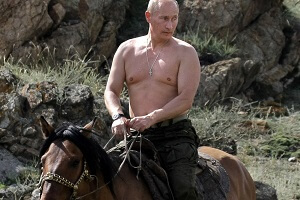
Putin is profoundly nationalist, anti-NATO, and a supporter of a strong sphere of influence. He opposed the color revolutions and accession to democracy in Ukraine (2004) and in Kyrgyzstan (2005). In 2007, he criticized the American influence in international relations in what is now known as the Munich speech. He invaded Ossetia and Georgia in 2008, where “peace enforcement” soon proceeded. That year, he also declared to NATO that Ukraine’s accession to the defense treaty would mean annexation of Ukraine and Crimea.
Putin has been a thorny issues and a troublemaker of international politics all along.
- He supported Castro in his old age. He sold billions of military equipment to Venezuela‘s Maduro in 2005, and helped the country in accessing financial markets through crypto currencies. He supported Iran-Russian relations in 2007. He visited and supported Gaddafi in 2008, and denounced his death as an assassination. He has been propping the Syrian dictator Bashar Al-Assad since the 2000’s, opposing the international demand for his resignation and vetoing any sanction. He helped the country destroy its chemical weapons.
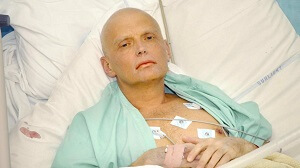 Putin has killed many opponents. He prosecuted and ruined Mikhail Khodorkovsky, then Russia’s richest man, for supporting opponents financially. He is unforgiving to ex-KGB agents. Alexander Litvinenko drank Polonium tea, and died in excruciating pains in 2006. Sergei Skripial was infected with the Nochikov nerve agent in 2018, but survived.
Putin has killed many opponents. He prosecuted and ruined Mikhail Khodorkovsky, then Russia’s richest man, for supporting opponents financially. He is unforgiving to ex-KGB agents. Alexander Litvinenko drank Polonium tea, and died in excruciating pains in 2006. Sergei Skripial was infected with the Nochikov nerve agent in 2018, but survived.- Many political opponents and journalists simply died of violent unexplained deaths. The list is long. Magnistky died in prison in 2009, where he had been sent after having accused the Russian government of corruption. Boris Nemtsov was killed in central Moscow in 2015, a few hours after encouraging an anti-Ukrainian war protest. Alexei Navalny, a long-time political activist, was poisoned during a 2020 flight. He managed to fly to Berlin where doctors saved his life. He was jailed upon returning home, and released a must-see documentary on Putin’s corruption two days later.
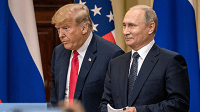 In 2016, Putin congratulated Trump for winning the US presidential elections; Russian fingerprints were visible all over the election – social media influence, cyber hacking and information sharing. Putin seemed to have a strong influence on the president during the following 4 years.
In 2016, Putin congratulated Trump for winning the US presidential elections; Russian fingerprints were visible all over the election – social media influence, cyber hacking and information sharing. Putin seemed to have a strong influence on the president during the following 4 years.- Russia is highly suspected of having influenced the 2016 Brexit referendum, if not the 2014 Scottish independence vote.
The reorganization of the Russian army.
The fall of the USSR in 1991 left Russia with old military equipment, as the departing countries were better equipped. Since 2008, Russia has profoundly revamped its military and defense industry.
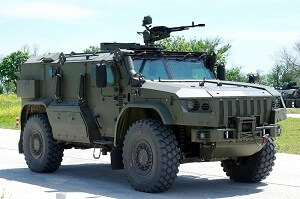
Putin has reduced headcounts, concentrated training centers, reduced the number of military districts, moved towards a professional army. He used petrodollars to invest in modern equipment. The budgets have steadily increased (in rubbles, not in dollars). He has resumed development of nuclear capabilities, re-invested in the navy (submarines, aircraft carrier), although both the Navy and the Airforce were reduced overall. New tanks, new soldier equipment, better pay, fewer officers and more NCOs. Heavy research in technologies. Many opportunities to battle-test these equipment in real-life conflicts.
Military exports went down a bit, due to the loss of India as a main client, but Russia remains the second-largest arms exporter. He even managed some high-profile sales, like air defenses to Turkey, a NATO country! The Russian army, ranked the 2nd strongest in the world, is probably much more lethal than it used to be.
Ukraine’s recent history
Ukraine became an independent state through the fall of the Soviet Union. In a December 1990 referendum, 90% of the country voted in favor of secession, including Crimea (with 56% of the votes). The separation turned out economically hard, as a decade-long economic recession and crisis unfolded.
The second presidency (Leonid Kuchma) saw solid corruption. The pro-Russian prime minister Viktor Yanukovych was then elected with a narrow margin, and many accusations of vote-rigging. Protests ensued, until the Supreme court canceled the election. The Pro-European Yuschenko was elected soon after.
 The old president Viktor Yanukovych nevertheless won the next election and came back to power in 2010. In 2013, he renounced a friendship treaty with Europe, in favor of closer ties with Russia. That decision sparked a second wave of protests; a revolution ensued. He eventually fled the country for Russia in 2014.
The old president Viktor Yanukovych nevertheless won the next election and came back to power in 2010. In 2013, he renounced a friendship treaty with Europe, in favor of closer ties with Russia. That decision sparked a second wave of protests; a revolution ensued. He eventually fled the country for Russia in 2014.

Two months later, Russia annexed Crimea. During the occupation, separatists held a referendum – denounced by the West as illegal – which saw a 90% pro-Russian vote. Separatists and Russian advisors have been running a low-intensity war against Kyiv’s troops since then, despite two peace agreements.
14,000 Ukrainians have died so far and 1.5 millions were displaced. Russia also annexed trillions of dollars of gas reserves off the Ukrainian coasts. It took control of Sevastopol, which housed 75% of the Ukrainian fleet. Russia was banned from the G8, and has been under economic sanctions ever since.
In 2019, the constitution was amended to facilitate an eventual membership with the European Union and with NATO. In 2020, The Baltic states and Ukraine signed a cooperation agreement to further Ukraine’s integration into the EU and NATO. In May 2021, NATO confirmed its 2008 decision to welcome Georgia and Ukraine into NATO, through the Membership Action Plan. Ukraine is expected to apply for EU membership in 2024.
The military build-up.
Former Eastern countries leaving the USSR is hard to swallow for a KGB agent. Seeing the Baltic states and Poland join NATO was even harder. That Ukraine, its industrial and military building heartland, joins the opposite camp is an insult, and an obsession. Putin has called Ukraine an ‘unfinished business‘ with no historical right to independence.
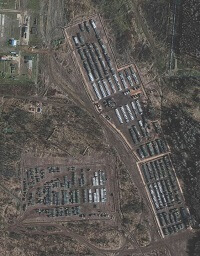
Russia has recently built a strong military presence a few hundred miles away from the Ukrainian border – in the name of military exercises, of course. The forces are significant, larger than those lined up in 2014: over 100 battalion tactical groups, or 100,000 troops (about 10% of Russian forces), rows of trucks, 1,600 artilleries, 1,200 tanks, 2,900 armored vehicles, 330 planes, 240 helicopters, field hospitals… An airborne assault brigade (4,000 troops) is also deployed.
The positioning of these forces, all around Ukraine, indicates the intent to a major offensive across the entire country.
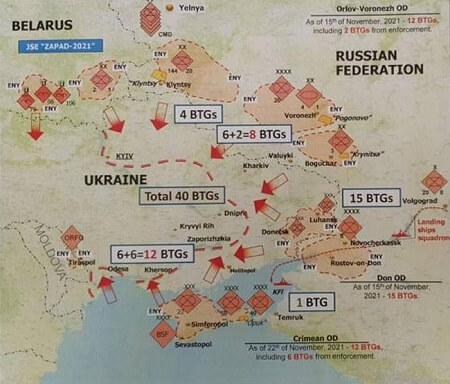
On the other side, the Ukrainians may be better armed than in the past, but they have only 20-25,000 troops.
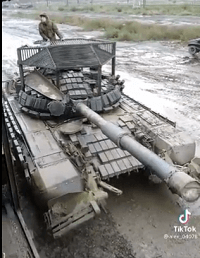
There is more to it than just an expensive military build-up:
- A tank apparently crossed the border. Interestingly enough, Russian tanks have an amateurish protection on top (also seen here), probably against American Javelin anti-tank missiles (they shoot down on the less armored tank top), or the Turkish TB-2 drones.
- Meanwhile, the Russians are saying that Ukrainians are bombing cities.
- Ukrainian are also seeing a significant increase in cyber & propaganda, and the Russian statements about Ukrainian aggressions would fit that play well.
- The Ukrainian president says that a coup plot against him (also here) was averted a week ago.
- Belarus, a staunch Russian ally, just accused a Ukrainian helicopter of violating its air space.
A political move.
There is little doubt that Russia’s build-up is a political move. Although his intentions are unclear, Putin is probably
- asking for guarantees that Ukraine will not join NATO – a non-starter for both NATO and Biden
- or that NATO troops would not set foot in Ukraine (his little green men in Crimea never were Russian, right?)
- as well as asking that no major weapon system would be deployed eastwards from the former Eastern countries
- raise the stakes to scare Ukrainians into its views, which has been counter-efficient so far, to say the least
- scare the West into abandoning Ukraine
- leverage China’s increasingly assertive geopolitical strategy, even if the US army is able to hold two major fronts at the same time
- and keep on using Ukraine as a “petri dish” to test military equipment and cyber-attacks.
- More importantly, Putin wants to become again a central piece in the world of superpowers and regain the parity to the United States that it enjoyed during the Cold War. I don’t think the Western diplomatic apparatus has any intention of giving such a favor away.
Fiona Hill, a top Russia advisor in the Trump administration, believes “there has never been a more propitious moment for Putin if he wants to invade Ukraine”…
What can/should the West do?
A few things come to mind:
- First of all, not give Russia a reason to attack. There’s no need for provocation at this stage.
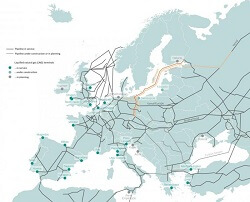 The West can leverage the Nord Stream 2 pipeline, which will link the Siberian gas field directly to Germany through the Baltic sea. This new conduit for gas is not intended to increase distribution to Europe (Russia will not increase its production), but simply to divert the distribution away from Ukraine, hence removing a tool in Ukraine’s leverage arsenal, reducing Europe’s interest in Ukraine, while cutting Ukrainian GDP by 3%. Nobody is naïve about the true intent of the development. The Germans are actually insisting that gas flows through Ukraine. The Europeans and the international community are reluctant as well. The whole affair could turn against Putin; there is little doubt that the pipeline would not be authorized if Russia were to attack Ukraine, at the sole expense of Gazprom, the Russian companies which built it entirely.
The West can leverage the Nord Stream 2 pipeline, which will link the Siberian gas field directly to Germany through the Baltic sea. This new conduit for gas is not intended to increase distribution to Europe (Russia will not increase its production), but simply to divert the distribution away from Ukraine, hence removing a tool in Ukraine’s leverage arsenal, reducing Europe’s interest in Ukraine, while cutting Ukrainian GDP by 3%. Nobody is naïve about the true intent of the development. The Germans are actually insisting that gas flows through Ukraine. The Europeans and the international community are reluctant as well. The whole affair could turn against Putin; there is little doubt that the pipeline would not be authorized if Russia were to attack Ukraine, at the sole expense of Gazprom, the Russian companies which built it entirely.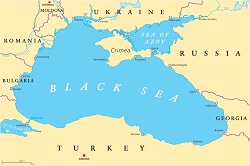 The West may be forced into revising its policy for the Black Sea, a complex issue, an bring in the area a stronger military, economic, democratic and political influence. It could create a NATO hub in the region. It could help EU integration locally or the Three Seas Initiative. All these actions would be significantly detrimental to Russia in the long-term, without creating any casus belli. It would be a slap to Putin, which considers the area its private garden. Actually, recent gas reserve discoveries indicate that Europe may have a development interest, and become far less dependent on Russian gas.
The West may be forced into revising its policy for the Black Sea, a complex issue, an bring in the area a stronger military, economic, democratic and political influence. It could create a NATO hub in the region. It could help EU integration locally or the Three Seas Initiative. All these actions would be significantly detrimental to Russia in the long-term, without creating any casus belli. It would be a slap to Putin, which considers the area its private garden. Actually, recent gas reserve discoveries indicate that Europe may have a development interest, and become far less dependent on Russian gas.- The US can offer more financial and military support to Ukraine. Congress is actually considering an increase by $60 m of its annual help to Ukraine, including with lethal forces. The Pentagon just announced $125m of military aid in March.
- The United States has warned Russia of “serious consequences” if Moscow decided to pursue confrontation. Biden pledged to make it “very, very difficult” for Putin to take military action.
- You can probably think of strong economic sanctions, which is what Anthony Blinken, the US Secretary of State, has just clearly re-affirmed. It could include cutting Russia from the SWIFT international payment system, which would cripple the Russian economy. When Iran was cut, it lost 50% of its oil revenues and a third of its foreign trade. The movement had been considered in 2014, and Medvedev classified it as a “declaration of war”. It is a last resort avenue though, as it would hurt Europeans as well (how about a cold winter to start with?).
- In last resort, admitting Ukraine to NATO would be the ultimate deterrence. Russia would face an enormous alliance against it, hence its intent to act before it is too late.
 Are we ready to die for Dantzig?
Are we ready to die for Dantzig?
It seems that the lessons of history have been understood by both sides.
- Putin is moving his pieces on the international geopolitical chessboard much more slowly than Hitler did.
- The Mutually Assured Destruction brought by nuclear armament has probably helped, but the West has certainly constructed an extremely resilient defense against the Eastern bloc. NATO, and its article 7, has been the most powerful tool for peace in the last half century. Moscow knows this well.
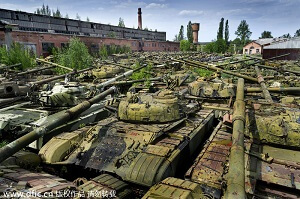
Russia is saber-rattling in Ukraine, but the West’s focus on Ukraine is unwavering. Biden will probably state it again to Putin during their expected conversation next week.
We chose not to die for Dantzig, but our commitment to die for Kyiv will probably hold Russia back.
References
- The Washington Post, March 23, 2017: Here are 10 critics of Vladimir Putin who died violently or in suspicious ways
- Radio Free Europe / Radio Liberty, February 25, 2019: The Changing Story Of Russia’s ‘Little Green Men’ Invasion
- CNBC, May 21, 2019: Nord Stream 2 explained: What it is and why it’s proving controversial
- Youtube / Alexei Navalny, Jauary 19, 2021: Putin’s palace. History of world’s largest bribe (also below)
- Kremlin, July 12, 2021: Article by Vladimir Putin ”On the Historical Unity of Russians and Ukrainians“
- Defense News, September 1, 2021: US commits to $60 million in aid to Ukraine before WH visit
- Clean Energy Wire, September 9, 2021: Gas pipeline Nord Stream 2 links Germany to Russia, but splits Europe
- Center for European Policy Analysis, October 27, 2021: Black Sea Security: Reviving US Policy Toward the Region
- The Independent, November 26, 2021: Ukraine president says coup plot uncovered as Russian tensions grow
- The Atlantic Council, November 27, 2021: Vladimir Putin’s Ukraine obsession could spark a major European war
- Reuters, December 1, 2021: U.S. tells Russia to pull back from Ukraine or face painful sanctions
- EuroNews, December 2, 2021: US ‘will respond’ if Russia ‘acts recklessly’ against Ukraine, Blinken tells Lavrov
- US News, December 3, 2021: US Intelligence Finds Russia Planning Ukraine Offensive
- Associated Press, December 5, 2021: Belarus alleges airspace violation; Ukraine calls claim fake



